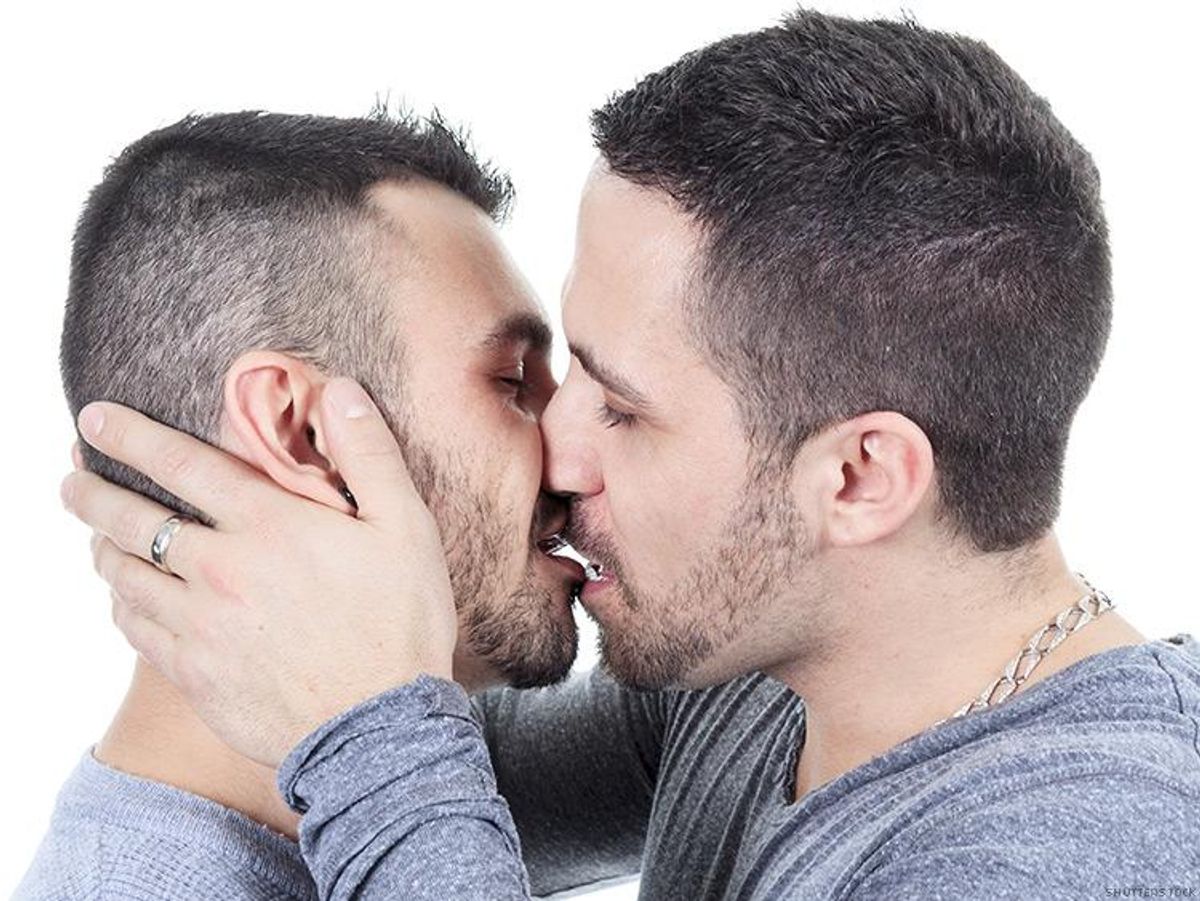In the early days of the AIDS crisis, the collective desperation to curb new contractions led to confusion over which practices were high-risk, even among HIV activists and the medical professionals working to fight the virus. Once it became clear that HIV and AIDS were not “gay-only” diseases, prevention efforts targeted dangerous behavior rather than people. But people of one sexual orientation are still fighting a powerful stigma that has persisted for more than 30 years.
“I have had women suggest that because I am bisexual, I spread HIV,” says Khafre Kujichagulia Abif, a 49-year-old married bisexual man, writer, and Atlanta-based activist who is HIV-positive. (Abif is also a contributor to Plus magazine).
The theory is so pervasive that many bisexual activists can’t even recall the first time they heard it: Bisexual men are responsible for "infecting" their female partners with HIV. In essence, the theory argues, men who have sex with men and women must have a higher likelihood of contracting HIV, and because they have sex with women, they are more likely to infect heterosexual women, who would otherwise be unlikely to come into contact with the virus.
Khafre Kujichagulia Abif (photo by Duane Cramer)

But according to the scientist who recently completed the first comprehensive review of scientific literature around the prevalence of HIV among men who have sex with men (MSM) compared to men who have sex with men and women (MSMW), there certainly isn’t enough information about bisexual men to make such a claim.
M. Reuel Friedman, Ph.D., MPH, confirms that bisexual men can acquire HIV from and transmit it to both men and women, whether those partners are bisexual, gay, or straight. But that doesn’t mean that bisexual men are any more likely to transmit the virus than any other group, he says. The truth is more nuanced.
In a comprehensive report published in 2014, Friedman and his colleagues from the University of Pittsburgh’s Graduate School of Public Health and Pitt’s Center for LGBT Research set out to determine the number of HIV-positive men who behave in a bisexual manner (meaning they have sex with men and women, regardless of how they self-identify). Then his team determined how HIV prevalence differs in bisexual men versus gay men. The report was the first of its kind to analyze existing research about HIV-positive bisexual and gay men.
“Our meta-analysis shows that bisexually behaving men are significantly more likely than heterosexually behaving men to have HIV but significantly less likely than gay-behaving men to have HIV,” Friedman tells HIV Plus.
But if bisexuals don’t have a higher prevalence of HIV than other minority groups, why does the belief persist that they are the so-called bridge to infecting heterosexual women?
Friedman says the answer to that question is multifaceted. Partially, the perception has gained traction because it’s hard to obtain accurate information about the incidence (new diagnoses) and prevalence (proportion of cases overall) of HIV in people who are bisexual, since national reporting standards only distinguish gay men and straight men, simply lumping bisexual men in with the gay men.
He estimates there are 121,800 HIV-positive men in the U.S. who are bisexually behaving. That’s similar, he notes, to the number of heterosexual men and male injection drug users who are living with HIV and AIDS, according to estimates by the Centers for Disease Control and Prevention.
Similarly, most studies don’t distinguish women who have sex with bisexual men from women who only have sex with straight men, so it’s tough to trace the origins of new HIV infections in women who have sex with men. There simply isn’t enough accurate data to determine the source of these new infections. Nevertheless, because there are fewer bisexual men than heterosexual ones, and the total number (not the percentage) with HIV in each population is roughly equal, Friedman says that women who have sex with men are about as likely to encounter a heterosexual HIV-positive man as they are to encounter a bisexual HIV-positive man.
What’s more pivotal in publicizing the “overstated” connection between bisexual men and HIV, Friedman says, is the tendency of media to boil down complex issues to simplified stories that have a clear, identifiable villain — even if that results in an inaccurate portrayal.
“The general storyline of bisexual bridging has been a popular one in media accounts that favor simple narratives that play on fear,” says Friedman. “Whether it is fear of gay people, fear of bisexual people, fear of black people, and/or fear of HIV not being a purely ‘gay’ disease. Mass media, and even scientific literature, has not always reported in an unbiased way on bisexual people; then, when you bring in a sexually transmitted infection that is almost always fatal if untreated, and a highly disproportionate infection rate among African-Americans, you have a sort of jet fuel for incendiary press.”
A 2014 report in the New York Post adopted this line of thinking, claiming that three-quarters of women reporting new HIV infections contracted the virus from bisexual men.
“Women who had unprotected sex with bisexual partners accounted for most of the new female HIV cases in [New York City] last year,” the Post reported in its brief on a study from the city’s health department.
But that conclusion isn’t supported by the data, since it completely ignores the reality that HIV transmission can occur between heterosexual men and women, Friedman notes.
Ron Suresha (below)

“Unfortunately, heterosexual men can and do acquire HIV from heterosexual sex, and they can and do transmit it to heterosexual women,” says Friedman. “Heterosexual men can also acquire HIV through other means, such as injection drug use, and then transmit it sexually to female partners.”
“By ignoring HIV transmission in completely heterosexual people, media accounts have tended to blame bisexual men for all sexually acquired HIV among women,” says Friedman, pointing to the Post article as just one example. “The whole ‘down low’ media phenomenon that occurred in the early 2000s is also an example of that, and it really wound up demonizing black male sexuality — in particular black male bisexuality.”
Indeed, lurid reports about the “down low” lifestyle chronicle a supposed subculture of African-American men who are secretive about their same-sex encounters, allegedly “bringing home” their undisclosed HIV infection to their female partners and spouses.
But Dr. Herukhuti, 41, a Brooklyn-based cultural studies scholar, sexologist, and educator who identifies as a polysexual black cisgender* man, says the focus on demonizing black sexuality, in particular, has deeper roots than simple misunderstanding.
“This is a sexist and racist assumption,” Herukhuti writes of the “down low” narrative in his book Conjuring Black Funk: Notes on Culture, Sexuality, and Spirituality. “It disempowers Black women sexually, intellectually, and morally as well as demonizes Black men, while ignoring the systemic and structural forces at work in a racist, sexist, heterosexist, erotophobic, and classist society that places Black women and Black men at greater risk of poverty, death, and disease.”
Herukhuti also warns about the implications of a culture blaming new HIV infections on already marginalized groups, be they African-Americans, bisexual people, or both.
“The impact of the [bisexual bridge] myth is women having misinformation about HIV transmission, bisexuality, and gender that put them at greater risk for exposure to HIV,” Herukhuti tells Plus. “It also imposes artificial limitations on women who are seeking viable male partners — making the effort to find love, intimacy, and commitment with someone that much more difficult.”
Friedman agrees, noting that decades of unchallenged assumptions about the behavior of bisexual people — especially bisexual men of color — has created a complicated, multilayered closet that makes being honest about one’s HIV status or sexual orientation difficult.
“I think that the context in which bisexual men are discussed in mainstream media has been confined largely to HIV bridging since the advent of the epidemic,” he explains. “So that’s 30 years of this undercurrent that bisexual men are responsible for HIV in women, without other competing social narratives. In my opinion, that meme is very damaging to the self-esteem of bisexual men, but that has not been studied, so we have no scientific support for that statement.”
But bisexual men, both negative and positive, tell Plus that the stigmas surrounding their identities do indeed take a toll on their well-being.
“The result is that all bi men are stereotyped and discriminated against,” with bisexual men who are married to women bearing “the brunt of this stigma. This effectively divides the queer male community,” says Ron Suresha, a 59-year-old writer, editor, and cofounder of Bear Bones Books, who identifies as a cisgender bear who is gay, bi, and queer. “I’d like to point out that a significant portion of bisexual men are, like myself, in long-term, safe-only, primary relationships with men, with relatively infrequent sexual contact with women. We think of bi men as only being married men cheating on their wives, but there are actually many kinds of bi guys around. This is just one of the common misperceptions of bi men as vectors of HIV transmission to women.”
“Even though HIV transmission among IV drug users poses a significant challenge, the point of HIV transmission being sex-based often was shunned with the insulting abstinence mantra,” explains Paul Nocera, a 53-year-old bisexual queer man who serves as the lead facilitator of BiRequest, a social and discussion group for bisexual people and their friends and allies based in New York City.
“Bisexuals are seen, likewise, as unable to keep it zipped up. Our supposed constant desire was what was getting us into trouble, and as proof, there was the imagined pathway, with the imagined spike in sex diseases. The weave of stigma is a tight one.”
Nocera argues that as a result of that stigmatizing stance, “We’ve wasted precious hours chasing and chastising when we could be doing better science and more effective interventions on all levels.”
Dr. Herukhuti (below)

Herukhuti agrees that the way to combat intertwining stigmas is through education and honesty.“I think it is important to the process of addressing prejudice against bisexual men and debunking myths, like the bisexual HIV myth, that people learn about more bisexual men — our stories, lives, and experiences.”
Similarly, Abif, the bisexual, HIV-positive activist, writer, and nonprofit manager, says combating stigma begins at home.
“The first step in protecting myself and protecting others from transmission is accepting who I am and the behavior I engage in,” he says of being open about his bisexuality and his HIV status. “There is no disconnect between who I say I am and what I do sexually. The stigma surrounding HIV and bisexuality come from a place of lack of knowledge, and understanding. Not enough people have open and honest discussions about HIV and sexuality. Far too many people have sexual partners with whom they have never had a conversation about HIV, STIs, and their own sexuality. Too many men never really share with their female partner all of what turns them on.”
* Cisgender is a term used to describe those who are not transgender; people whose gender identity corresponds with the sex they were assigned at birth.














































































